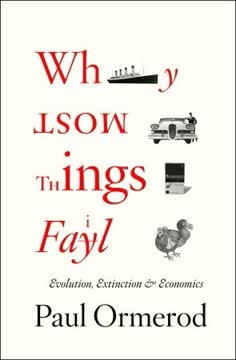Key Takeaways
1. Economic systems are complex living organisms, not predictable machines
Economies and societies are not machines. They are more like living organisms.
Biological analogies: The economy behaves more like a complex ecosystem than a mechanical device. Like living systems, economies exhibit emergent properties that arise from the interactions of many individual agents. This perspective challenges the conventional view of economies as predictable, controllable machines.
Implications: This shift in understanding has profound implications for economic policy and forecasting. Just as ecosystems are difficult to control precisely, economies resist top-down management and precise prediction. Policy makers should focus on creating favorable conditions for growth and adaptation rather than attempting to fine-tune every aspect of the economy.
Key characteristics of economies as living systems:
- Adaptive and self-organizing
- Exhibit non-linear behavior
- Sensitive to initial conditions
- Capable of sudden, large-scale changes
2. Individual behavior is directly influenced by others, creating self-reinforcing patterns
Popular toys or films become even more popular precisely because they are popular.
Social influence: Unlike conventional economic models that assume fixed individual preferences, real-world behavior is heavily influenced by the actions of others. This creates feedback loops and self-reinforcing patterns in areas like consumer trends, financial markets, and technology adoption.
Network effects: The influence of others can lead to powerful network effects, where the value of a product or service increases as more people use it. This explains phenomena like the dominance of certain technologies (e.g., VHS over Betamax) or the rapid spread of social media platforms.
Examples of self-reinforcing patterns:
- Fashion trends
- Stock market bubbles and crashes
- Viral content on social media
- Adoption of new technologies
- Regional economic clusters (e.g., Silicon Valley)
3. Short-term economic forecasting and control are largely illusory
The control which governments believe they have – in their ability to make reasonably accurate forecasts and to understand the consequences of policy changes designed to alter the outcome – is largely illusory.
Limitations of forecasting: Despite sophisticated models and extensive data, short-term economic forecasting remains highly inaccurate. The complex, non-linear nature of economic systems makes precise prediction impossible, much like weather forecasting beyond a few days.
Policy implications: This uncertainty undermines the effectiveness of fine-tuned economic policies. Governments often act on forecasts that are little better than educated guesses, potentially exacerbating economic fluctuations rather than smoothing them out.
Reasons for forecasting failures:
- Inherent unpredictability of complex systems
- Inability to account for all relevant variables
- Feedback loops and self-fulfilling/self-defeating prophecies
- Structural changes in the economy over time
4. Conventional economic models fail to capture real-world complexity
Orthodox economics is mistaken when it views the economy and society as a machine, whose behaviour, no matter how complicated, is ultimately predictable and controllable.
Limitations of orthodox models: Traditional economic models rely on simplifying assumptions that often fail to capture critical aspects of real-world behavior. These models assume rational actors with fixed preferences, perfect information, and predictable responses to incentives.
Need for new approaches: More realistic models must incorporate concepts from complexity science, behavioral economics, and network theory. These approaches can better account for phenomena like herd behavior in financial markets, the emergence of new industries, and the persistence of economic inequality.
Key shortcomings of conventional models:
- Assumption of rational, utility-maximizing agents
- Reliance on equilibrium concepts
- Difficulty in modeling innovation and technological change
- Inability to account for institutional factors and cultural differences
5. Business cycles arise from interactions between firms, not external shocks
The business cycle is one of the two most pervasive and important characteristics of the Western market economies.
Endogenous cycles: Rather than resulting from external shocks, business cycles emerge naturally from the interactions between firms and their responses to changing economic conditions. This challenges the conventional view that cycles are primarily driven by external factors like technological innovations or government policies.
Expectations and sentiment: A key driver of business cycles is the changing expectations and sentiment of firms. Optimism leads to increased investment and hiring, while pessimism results in cutbacks. These shifts in sentiment can become self-reinforcing, creating boom and bust cycles.
Components of the business cycle model:
- Firm-level decision making based on current conditions and expectations
- Interactions between firms (e.g., supplier-customer relationships)
- Feedback loops between sentiment and economic activity
- Inherent delays and adjustments in economic processes
6. Long-term economic growth emerges from firm-level increasing returns
Firms are driven by profits, and are constantly striving to reap the benefits of increasing returns in all aspects of their activities.
Micro-foundations of growth: Long-term economic growth is not primarily driven by aggregate factors like capital accumulation or labor force growth. Instead, it emerges from the activities of individual firms seeking to exploit increasing returns to scale in various aspects of their operations.
Positive feedback loops: Successful firms can leverage their initial advantages to grow even larger and more efficient. This process creates a power-law distribution of firm sizes, with a small number of very large firms dominating many industries.
Sources of increasing returns:
- Economies of scale in production
- Network effects in technology and platforms
- Learning and innovation advantages of larger firms
- Market power and brand recognition
- Control over distribution channels
7. Policy should focus on broad frameworks, not short-term interventions
Governments should step back and take a wider perspective rather than constantly intervening.
Long-term perspective: Given the inherent unpredictability of economic systems, policy makers should focus on creating favorable conditions for growth and innovation rather than attempting to fine-tune short-term economic outcomes.
Institutional quality: The most effective policies are those that improve the overall institutional framework of the economy. This includes factors like rule of law, property rights, education systems, and infrastructure.
Key areas for policy focus:
- Maintaining macroeconomic stability
- Fostering competition and market openness
- Investing in human capital and education
- Supporting basic research and innovation
- Developing robust financial systems and capital markets
8. New mathematical and computational tools enable better economic modeling
The complex inter-relations between the behaviour of individuals and the overall outcome lead to arguments of subtlety and refinement which are underpinned by the new maths of the analysis of society.
Advances in methodology: Recent developments in mathematics, computer science, and data analysis provide powerful new tools for modeling complex economic systems. These include agent-based modeling, network analysis, and machine learning techniques.
Data-driven insights: The increasing availability of large-scale economic data, combined with new analytical tools, allows for more empirically grounded and nuanced economic models. This enables researchers to better capture real-world complexity and test theoretical predictions.
Key methodological advances:
- Agent-based computational models
- Network analysis and graph theory
- Non-linear dynamics and chaos theory
- Machine learning and artificial intelligence
- Big data analytics and natural language processing
Last updated:
Review Summary
Butterfly Economics receives mixed reviews, with an average rating of 3.69/5. Readers appreciate Ormerod's innovative approach, combining economics with psychology to explain human behavior and its impact on markets. The ant experiment analogy is frequently mentioned as intriguing, though some find it overused. Many readers find the book insightful and thought-provoking, particularly in challenging traditional economic theories. However, some criticize the later chapters as dry and academic, with a few readers struggling to maintain interest throughout.
Download PDF
Download EPUB
.epub digital book format is ideal for reading ebooks on phones, tablets, and e-readers.





